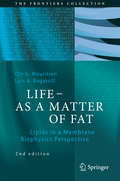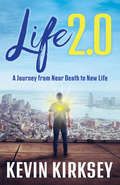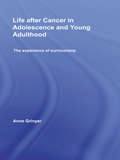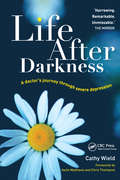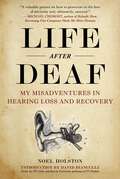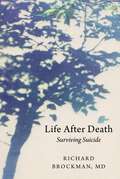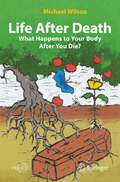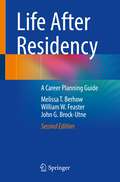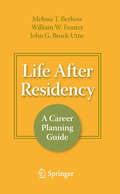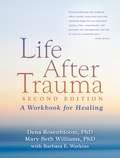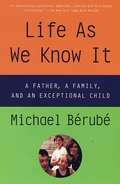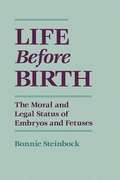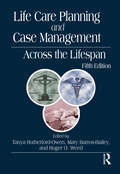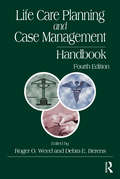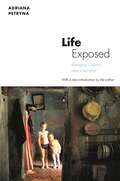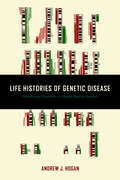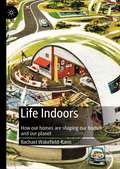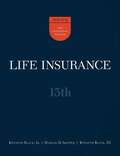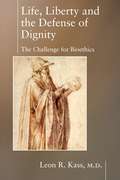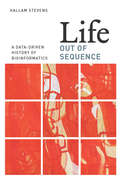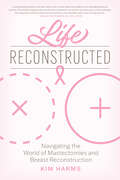- Table View
- List View
Life - As A Matter Of Fat
by Ole G. Mouritsen Luis A. BagatolliThe present book gives a multi-disciplinary perspective on the physics of life and the particular role played by lipids (fats) and the lipid-bilayer component of cell membranes. The emphasis is on the physical properties of lipid membranes seen as soft and molecularly structured interfaces. By combining and synthesizing insights obtained from a variety of recent studies, an attempt is made to clarify what membrane structure is and how it can be quantitatively described. Furthermore, it is shown how biological function mediated by membranes is controlled by lipid membrane structure and organization on length scales ranging from the size of the individual molecule, across molecular assemblies of proteins and lipid domains in the range of nanometers, to the size of whole cells. Applications of lipids in nanotechnology and biomedicine are also described. The first edition of the present book was published in 2005 when lipidomics was still very much an emerging science and lipids about to be recognized as being as important for life as proteins, sugars, and genes. This significantly expanded and revised edition takes into account the tremendous amount of knowledge gained over the past decade. In addition, the book now includes more tutorial material on the biochemistry of lipids and the principles of lipid self-assembly. The book is aimed at undergraduate students and young research workers within physics, chemistry, biochemistry, molecular biology, nutrition, as well as pharmaceutical and biomedical sciences. From the reviews of the first edition: "This is a highly interesting book and a pleasure to read. It represents a new and excellent pedagogical introduction to the field of lipids and the biophysics of biological membranes. I reckon that physicists and chemists as well as biologists will benefit from this approach to the field and Mouritsen shows a deep insight into the physical chemistry of lipids. " (Göran Lindblom, Chemistry and Physics of Lipids 2005, vol. 135, page 105-106) "The book takes the reader on an exciting journey through the lipid world, and Mouritsen attracts the attention with a lively style of writing . . . . a comprehensive view of the 'lipid sea' can be easily achieved, gaining the right perspectives for envisaging future developments in the nascent field of lipidomics. " (Carla Ferreri, ChemBioChem, Vol. 6 (8), 2005)
Life 2.0: A Journey from Near Death to New Life
by Kevin KirkseyAn inspirational memoir of one man’s transformation after being near-death and witnessing the selfless acts of others.One day, while leaving a routine doctor’s appointment, Kevin asks his doctor a simple question that later proves to save, extend, and profoundly change his life—a question he believes is divinely inspired. Life 2.0 follows Kevin’s journey through open-heart surgery and recovery. But, more than that, this is the story of the impact little things can have when people open their hearts.As Kevin journeys through recovery and rehabilitation, he starts to notice the selfless little things others do—and develops a new perspective on life. Coupled with encounters with Angels, Kevin’s new life is molded into a life of profound physical, emotional, and spiritual change, and he decided to call it Life 2.0. An inspiration for healthcare providers, patients, and their families, Life 2.0 demonstrates how the little things can profoundly impact the lives of others and how anyone, if they so choose, can live their own Life 2.0.“Kevin has not only redefined the world around him, but his ability to inspire and motivate others in the path of happiness and faith-filled living is remarkable! His love for family and care for all those who meet him have inspired me to be a better version of myself . . . imagine the world if we all rejoiced as Kevin does in Life 2.0.” —Susan K. Moats, DNP, MBA, RN, NEA, BC, Chief Nursing Officer, Vice President of Patient Care Services
Life After Cancer in Adolescence and Young Adulthood: The Experience of Survivorship
by Anne GrinyerAdolescence and young adulthood is often a difficult enough time without serious illness. However, research has shown that cancer, and surviving cancer, at this age presents distinctive problems medically, socially and psychologically. This important work offers a glimpse into a previously under-researched area and contributes to a better understanding of the needs of young adults post cancer. Focusing not only on the physical effects, but also the social, cognitive, emotional and physiological consequences of surviving cancer in young adulthood, Anne Grinyer draws directly upon data collected from young adults who have been treated for cancer. The book is structured around themes they raised such as fertility; life plans; identity; psychological effects and physical effects. These issues are drawn together in the final chapter and related to clinical and professional practice as well as current policy. This book presents the voices of those who have lived through the experience of cancer in young adulthood, and links them to the theoretical and analytical literature. It will be of interest to professionals and researchers in nursing, social work, counselling and medicine as well as medical sociologists, young adults living with cancer and survivors of young adult cancer.
Life After Darkness: A Doctor’s Journey Through Severe Depression
by Cathy WieldLife After Darkness is the remarkable and moving story of a doctor and mother of four who endured seven years of severe depression. Self-harm, attempted suicides and admissions to psychiatric units culminated in her resorting to brain surgery as a final attempt to escape her illness. The story of Cathy Wield covers the horrors of time spent in archaic institutions and the loss of any hope, to a full recovery following surgery. Today she has returned to her career and rediscovered the joys of life and her family. This story is one of hope from an often hidden and stigmatized disease.
Life After Deaf: My Misadventures in Hearing Loss and Recovery
by Noel HolstonFrom a renowned media critic to a man with sudden and full hearing loss, Noel Holston ran the gauntlet of diagnoses, health insurance, and cochlear implant surgery. On a spring night in 2010, Noel Holston, a journalist, songwriter, and storyteller, went to bed with reasonably intact hearing. By dawn, it was gone, thus beginning a long process of hearing-restoration that included misdiagnoses, an obstinate health-insurance bureaucracy, failed cochlear-implant surgery, and a second surgery that finally worked. He negotiated the gauntlet with a wry sense of humor and the aid of his supportive wife, Marty. Life After Deaf details his experience with warmth, understanding, and candor. It&’s the story not only of his way back to the world of the hearing, but of a great marriage that weathered serious testing. Their determination and resilience serve as a source of inspiration for all.Life After Deaf is not just for the more than forty million people in the United States alone who cope with some form of hearing loss, but is also for their wide circles of friends, family, caregivers, and audiologists. This highly readable book will be an invaluable guide and source of hope for the large number of baby boomers now handling hearing loss.
Life After Death: Surviving Suicide
by Richard BrockmanAn intertwined tale of a boy&’s world shattered by suicide and a man&’s story rewritten by neuroscience. When Richard Brockman found his mother&’s body, the simple narrative of his childhood ended. Life After Death tells the story of a boy who died and of a man who survived when the boy and the man are one and the same. It tells a very personal—yet tragically common—story of irredeemable loss. It tells the story of story itself. How story forms. How it grows. How it changes. How it can be broken. And finally, how sometimes it can be repaired. Now an expert in genetics, epigenetics, and the biology of attachment, Brockman chronicles his evolution from a child overwhelmed by trauma to a man who has struggled to reclaim his past. He lays bare the core of one who is both victim and healer. By weaving together childhood despair and clinical knowledge, Brockman shows how the shattered pieces of the self—though never the same and not without scars—can sometimes be put back together again.
Life After Death: What Happens to Your Body After You Die? (Springer Praxis Books)
by Michael WilsonDeath is not an end – it’s a new beginning. After death, all of the molecules that came together to form the living “you” become nutrients for millions of creatures, large and small. Your body becomes the hub of a complex ecosystem of microbes, insects, worms, plants and more. Cheer up! This book shows how you are going to live forever – as components of so many other wonderful creatures. It describes the science behind the remarkable recycling of your body. We begin with lessons about how your body functions, is a collection of valuable nutrients and is a home to millions of microbes. The book goes on to describe the various stages the body passes through as it decomposes following death. The microbes and insects that make use of your tissues are then introduced. Finally, you will learn about the enduring effects that your body will have on the wider biosphere. We are rich in valuable resources that will end up feeding an immense number and variety of other creatures. Inevitably, your body will support the continuation of life on our beautiful planet – this book describes how all this happens.
Life After Ninety
by Michael Bury Anthea HolmeIn Life After Ninety Micheal Bury and Anthea Holme have surveyed and interviewed 200 individuals, living at home and in institutions, to examine old age stereotypes and present a unique picture of the health, quality of life, and social circumstances of the very old. Longevity and the factors which promote it are also discussed, and throughout the book the concept of the 'life course' is employed, which brings together the biographical experiences of individuals, and the changing historical circumstances of the twentieth century, through which they have lived.
Life After Residency: A Career Planning Guide
by Melissa T. Berhow William W. Feaster John G. Brock-UtneThis 2nd edition has been updated and offers residents an even more useful, step-by-step guide to achieving a successful and fulfilling career in medicine. The book's authors began running seminars at Stanford to advise their residents on various important topics not traditionally taught in medical school or residency, but all essential for establishing a successful career in medicine. These topics include creating a curriculum vitae and landing a great job, financial advice for student loans and retirement planning, understanding malpractice insurance, applying to medical staffs, and other important topics. Each chapter from the previous edition is expanded and updated. New chapters have been added to address the following key topics:· EMRs· Payment for services· Leadership· Understanding hospital administration· Physician wellnessLoaded with sage advice and practical wisdom, Life After Residency, 2nd Edition continues to be an invaluable asset for every resident during the transition from residency to life thereafter.
Life After Residency: Increase Your Brain's Creativity, Energy, And Focus
by Melissa T. Berhow William W. Feaster John G. Brock-UtneLife After Residency: A Career Planning Guide is an insightful, step-by-step guide to achieving a successful and fulfilling career in medicine. As professors at Stanford University Medical Center, Drs. Melissa Berhow, William Feaster, and John Brock-Utne began running seminars to advise their residents not only on creating a curriculum vitae and landing a great job, but also on how to manage student loan payments and avoid pitfalls in the life of a physician. The immense success and ensuing demand for more seminars eventually gave rise to Life After Residency--a book which continues the seminar discussions in greater depth and magnitude, while maintaining a conversational writing style. Key topics covered include: preparing for a job interview, evaluating job offers and negotiating contracts, obtaining and maintaining the proper State license, applying for membership onto Medical Staffs, obtaining malpractice insurance, buying a house and investing for eventual retirement, and pursuing non-medical career options. Loaded with sage advice and practical wisdom, Life After Residency is an invaluable asset to every resident during the transition from residency to life thereafter.
Life After Trauma: A Workbook for Healing, 2nd Edition
by Dena Rosenbloom Mary Beth Williams Barbara E. WatkinsTrauma can turn your world upside down--afterward, nothing may look safe or familiar. This compassionate workbook has already helped tens of thousands of trauma survivors start rebuilding their lives. Full of practical strategies for coping and self-care, the book guides you toward reclaiming a solid sense of safety, self-worth, trust, and control, as well as the capacity to be close to others. The focus is on finding the way forward in your life today, no matter what has happened in the past. The updated second edition has a new section on managing emotions through mindfulness and an appendix on easing the stress of health care visits. Dozens of step-by-step questionnaires and exercises are included; you can download and print additional copies of these tools for repeated use.
Life And Death In Intensive Care
by Joan CassellLife and Death in Intensive Care offers a unique portrait of the surgical intensive care unit (SICU), the place in medical centers and hospitals where patients with the gravest medical conditions—from comas to terminal illness—are treated. Author Joan Cassell employs the concept of "moral economies" to explain the dilemmas that patients, families, and medical staff confront in treatment. Drawing upon her fieldwork conducted in both the United States and New Zealand, Cassell compares the moral outlooks and underlying principles of SICU nurses, residents, intensivists, and surgeons. Using real life examples, Life and Death in Intensive Care clearly presents the logic and values behind the SICU as well as the personalities, procedures, and pressures that characterize every case. Ultimately, Cassell demonstrates the differing systems of values, and the way cultural definitions of medical treatment inform how we treat the critically ill.
Life As We Know It: A Father, a Family, and an Exceptional Child
by Michael BerubeJamie was born with Down syndrome. He was immediately subject to the medical procedures, insurance and representations as our society designates him as disabled. This book describes not only the challenges of raising him but the challenge of seeing him as a person.
Life Before Birth: The Moral and Legal Status of Embryos and Fetuses (2nd Edition)
by Bonnie SteinbockThis book provides a framework for thinking clearly and coherently about the unborn. The book's thesis, the "interest view," states that all and only beings who have interests have moral standing, and only beings who possess conscious awareness have interests. The chapters apply the interest view, and explore the moral and legal aspects of a wide range of issues.
Life Care Planning and Case Management Across the Lifespan
by Roger O. Weed Tanya Rutherford-Owen Mary Barros-BaileyCelebrating 25 years since its first publication, the fifth edition of this best-selling text is the most up-to-date and complete resource available on what a life care planner does, how the life care planner does it, and issues that affect the day-to-day role of a life care planner. Now featuring new material on pediatric life care planning and case management, including brachial plexus injuries and neurodevelopmental disorders, this new edition provides guidance and planning for cases across the lifespan. It begins with a series of chapters examining ten different professional specializations that often contribute to a life care plan, before providing critical information for developing life care plans for individuals with different physical, mental, and cognitive conditions including spinal cord injury, brain injury, and chronic pain. Uniquely comprehensive, the book also includes chapters on the forensic and legal context of life care planning, as well as equipment/technology, evidence-based literature/resources, and special education/special needs planning relevant to pediatric life care planning. Also including chapters dedicated to life care planning methodology and life care planning research, this is an essential resource for anyone practicing or studying life care planning or managing the needs of those requiring chronic medical care over the lifespan.
Life Care Planning and Case Management Handbook
by Roger O. Weed Debra E. BerensLife care planning is an advanced collaborative case management specialty practice focused on assessing, evaluating, coordinating, consulting, planning for, and monitoring necessary services for individuals with complex medical care needs over their lifetime. This handbook provides a comprehensive resource for all people involved with catastrophic impairments and chronic medical care case management. The Life Care Planning and Case Management Handbook, Fourth Edition, begins by defining the roles played by each of the key team members working with the life care planner. It provides planners with insights critical to successful interactions with medical and health care–related professionals as well as the team members they are most likely to encounter as they work to build an accurate and reliable life care plan. Next, the text offers up-to-date information on the medical conditions most frequently encountered by the life care planner. The contributors, who are recognized experts in their disciplines, also address issues in forensic settings, ethics, standards, research, and credentials. The fourth edition includes numerous chapters on general issues, as well as updated standards of practice from the International Academy of Life Care Planners (IALCP), Life Care Planning Consensus Statements, and valuable step-by-step charts and checklists. Completely updated and expanded, this revised handbook now includes new chapters on multicultural considerations in life care planning, admissibility of life care plans in U.S. courts, and Canadian life care planning practice. Additionally, infused in other chapters, is new information on medical coding and costing for life care planners, life care planning in non-litigated contexts, as well as research and education within life care planning.
Life Exposed: Biological Citizens after Chernobyl (In-formation Ser.)
by Adriana PetrynaOn April 26, 1986, Unit Four of the Chernobyl nuclear reactor exploded in then Soviet Ukraine. More than 3.5 million people in Ukraine alone, not to mention many citizens of surrounding countries, are still suffering the effects. Life Exposed is the first book to comprehensively examine the vexed political, scientific, and social circumstances that followed the disaster. Tracing the story from an initial lack of disclosure to post-Soviet democratizing attempts to compensate sufferers, Adriana Petryna uses anthropological tools to take us into a world whose social realities are far more immediate and stark than those described by policymakers and scientists. She asks: What happens to politics when state officials fail to inform their fellow citizens of real threats to life? What are the moral and political consequences of remedies available in the wake of technological disasters? Through extensive research in state institutions, clinics, laboratories, and with affected families and workers of the so-called Zone, Petryna illustrates how the event and its aftermath have not only shaped the course of an independent nation but have made health a negotiated realm of entitlement. She tracks the emergence of a "biological citizenship" in which assaults on health become the coinage through which sufferers stake claims for biomedical resources, social equity, and human rights. Life Exposed provides an anthropological framework for understanding the politics of emergent democracies, the nature of citizenship claims, and everyday forms of survival as they are interwoven with the profound changes that accompanied the collapse of the Soviet Union.
Life Histories of Genetic Disease: Patterns and Prevention in Postwar Medical Genetics
by Andrew J. HoganA history of genetic testing warns that such tests may tell us more than we want to know.Medical geneticists began mapping the chromosomal infrastructure piece by piece in the 1970s by focusing on what was known about individual genetic disorders. Five decades later, their infrastructure had become an edifice for prevention, allowing today’s expecting parents to choose to test prenatally for hundreds of disease-specific mutations using powerful genetic testing platforms. In Life Histories of Genetic Disease, Andrew J. Hogan explores how various diseases were "made genetic" after 1960, with the long-term aim of treating and curing them using gene therapy. In the process, he explains, these disorders were located in the human genome and became targets for prenatal prevention, while the ongoing promise of gene therapy remained on the distant horizon.In narrating the history of research that contributed to diagnostic genetic medicine, Hogan describes the expanding scope of prenatal diagnosis and prevention. He draws on case studies of Prader-Willi, fragile X, DiGeorge, and velo-cardio-facial syndromes to illustrate that almost all testing in medical genetics is inseparable from the larger—and increasingly "big data"–oriented—aims of biomedical research. Hogan also reveals how contemporary genetic testing infrastructure reflects an intense collaboration among cytogeneticists, molecular biologists, and doctors specializing in human malformation.Hogan critiques the modern ideology of genetic prevention, which suggests that all pregnancies are at risk for genetic disease and should be subject to extensive genomic screening. He examines the dilemmas and ethics of the use of prenatal diagnostic information in an era when medical geneticists and biotechnology companies have begun offering whole genome prenatal screening—essentially searching for any disease-causing mutation. Hogan’s focus and analysis is animated by ongoing scientific and scholarly debates about the extent to which the preventive focus in contemporary medical genetics resembles the aims of earlier eugenicists. Written for historians, sociologists, and anthropologists of science and medicine, as well as bioethics scholars, physicians, geneticists, and families affected by genetic conditions, Life Histories of Genetic Disease is a profound exploration of the scientific culture surrounding malformation and mutation.
Life Histories of Genetic Disease: Patterns and Prevention in Postwar Medical Genetics
by Andrew J. HoganA richly detailed history that “uncovers the challenges and limitations of our increasing reliance on genetic data in medical decision making” (Shobita Parthasarathy, author of Building Genetic Medicine).Medical geneticists began mapping the chromosomal infrastructure piece by piece in the 1970s by focusing on what was known about individual genetic disorders. Five decades later, their infrastructure had become an edifice for prevention, allowing expectant parents to test prenatally for hundreds of disease-specific mutations using powerful genetic testing platforms. In this book, Andrew J. Hogan explores how various diseases were “made genetic” after 1960, with the long-term aim of treating and curing them using gene therapy. In the process, he explains, these disorders were located in the human genome and became targets for prenatal prevention, while the ongoing promise of gene therapy remained on the distant horizon.In narrating the history of research that contributed to diagnostic genetic medicine, Hogan describes the expanding scope of prenatal diagnosis and prevention. He draws on case studies of Prader-Willi, fragile X, DiGeorge, and velo-cardio-facial syndromes to illustrate that almost all testing in medical genetics is inseparable from the larger—and increasingly “big data”–oriented—aims of biomedical research. Hogan also reveals how contemporary genetic testing infrastructure reflects an intense collaboration among cytogeneticists, molecular biologists, and doctors specializing in human malformation.Hogan critiques the modern ideology of genetic prevention, which suggests all pregnancies are at risk for genetic disease and should be subject to extensive genomic screening. He examines the dilemmas and ethics of the use of prenatal diagnostic information in an era when medical geneticists and biotechnology companies offer whole genome prenatal screening—essentially searching for any disease-causing mutation. Hogan’s analysis is animated by ongoing scientific and scholarly debates about the extent to which the preventive focus in contemporary medical genetics resembles the aims of earlier eugenicists. Written for historians, sociologists, and anthropologists of science and medicine, as well as bioethics scholars, physicians, geneticists, and families affected by genetic conditions, Life Histories of Genetic Disease is a profound exploration of the scientific culture surrounding malformation and mutation.
Life Indoors: How our homes are shaping our bodies and our planet
by Rachael Wakefield-RannIn this timely and expansive book, Wakefield-Rann investigates how emerging disease ecologies are undermining definitions of health and immunity that have persisted since the 19th century, and had a formative influence over the design of not only homes, but entire cities. This wide-ranging account traces the links between the history of medicine, modernist design and architecture, the rise of inflammatory disease, the microbiomes of buildings and humans, antimicrobial resistance, and novel chemical pollutants, to show how indoor environments have made us as we have made them. In highlighting the processes that have been missed in designing perfectly controlled interior habitats, Life Indoors shows the limitations of dominant practices, classifications and philosophies to apprehend current indoor pathogen ecologies.
Life Insurance
by Kenneth Black Jr Harold D Skipper Kenneth Black IIIThis 15th edition of Life Insurance is published in recognition of the 100th anniversary of this book's first edition. That edition was published in 1915 and authored by Dr. Solomon S. Huebner, founder of the Wharton School's insurance program and of the Chartered Life Underwriter certification program. It was pioneering for setting out both insurance principles and practices in a single, expansive treatise aimed explicitly at students of the business, whether they were students in the traditional collegiate sense or those undertaking professional development studies. This edition continues that legacy. While the 14th edition represented a sweeping revision and was published not long ago, several factors compelled us to bring forward this edition. These included a desire to update several vitally important sections, such as the tax treatment of life insurance and the implementation of the Health Care and Affordability Act of 2010. We also discovered several portions of the 14th edition that needed clarification and others that benefitted from a deeper treatment. We also corrected several errors identified by helpful readers.
Life Liberty & the Defense of Dignity
by Leon KassAt the onset of Life, Liberty and the Defense of Dignity, Leon Kass gives us a status report on where we stand today: "Human nature itself lies on the operating table, ready for alteration, for eugenic and psychic 'enhancement,' for wholesale redesign. In leading laboratories, academic and industrial, new creators are confidently amassing their powers and quietly honing their skills. For anyone who cares about preserving our humanity, the time has come for paying attention." Trained as a medical doctor and biochemist, Dr. Kass has become one of our most provocative thinkers on bioethical issues. In Life, Liberty and the Defense of Dignity, he has written a book that grapples with the moral meaning of the new biomedical technologies now threatening to take us back to the future envisioned by Aldous Huxley in Brave New World. In a series of mediations on cloning, embryo research, the sale of organs, and the assault on mortality itself, Kass questions the wisdom of trying to break down the natural boundaries given us and to remake the human body into an instrument of our will. He also attempts to chart a course by which we might avoid the dehumanization of biotechnical "recreationism" without rejecting modern science or rejecting its genuine contributions to human welfare. Leon Kass writes profoundly about the limits of science and the limits of life, about what makes us human and gives us human dignity. Life, Liberty and the Defense of Dignity.
Life On Wheels: For the Active Wheelchair User
by Gary KarpThis book offers an initial road map to the lifelong, complex, and fascinating road of the disability experience. This book is primarily a guidebook for those with a mobility disability, with practical information about how to adapt your home, choose a wheelchair, explore your sexuality, take care of your body. This book is designed to help people make their adjustments sooner and more completely by explaining how one adapts to disability, and by addressing misconceptions that only delay your ability to adapt. Throughout it I have tried to foster the principles of choice, of control, and of your right to pursue your interests and convictions. Life on Wheels is also an effort to explain that inclusion is an innate right for everyone and that people with disabilities are excluded for reasons not based on a balanced or realistic understanding of what is possible. It's time our world caught up with the reality, closed that gap, and allowed millions of people with disabilities to play their full role in society.
Life Out of Sequence: A Data-Driven History of Bioinformatics
by Hallam StevensThirty years ago, the most likely place to find a biologist was standing at a laboratory bench, peering down a microscope, surrounded by flasks of chemicals and petri dishes full of bacteria. Today, you are just as likely to find him or her in a room that looks more like an office, poring over lines of code on computer screens. The use of computers in biology has radically transformed who biologists are, what they do, and how they understand life. In "Life Out of Sequence," Hallam Stevens looks inside this new landscape of digital scientific work. aaaaaaaaaaaStevens chronicles the emergence of bioinformaticsOCothe mode of working across and between biology, computing, mathematics, and statisticsOCofrom the 1960s to the present, seeking to understand how knowledge about life is made in and through virtual spaces. He shows how scientific data moves from living organisms into DNA sequencing machines, through software, and into databases, images, and scientific publications. What he reveals is a biology very different from the one of predigital days: a biology that includes not only biologists but also highly interdisciplinary teams of managers and workers; a biology that is more centered on DNA sequencing, but one that understands sequence in terms of dynamic cascades and highly interconnected networks. "Life Out of Sequence "thus offers the computational biology community welcome context for their own work while also giving the public a frontline perspective of what is going on in this rapidly changing field. "
Life Reconstructed: Navigating the World of Mastectomies and Breast Reconstruction
by Kim Harms1 in 8 women will develop invasive breast cancer over the course of her lifetime, but this is not just another cancer book. Breast cancer survivor Kim Harms combines her own experience with extensive research and walks readers through the process of mastectomy and breast reconstruction, weighing the pros and cons, detailing the physical and emotional costs, and laying out the questions cancer fighters need to ask to be their own best advocate. With a foreword by the medical director of Katzmann Breast Center and chapters on everything from the vulnerable feeling of exposing your breasts to &“everyone&” to the distinctions between reconstruction and augmentation (trust us, it&’s not a boob job!), Life Reconstructed is the compassionate, honest roadmap every breast cancer fighter needs on her journey to recovery.
